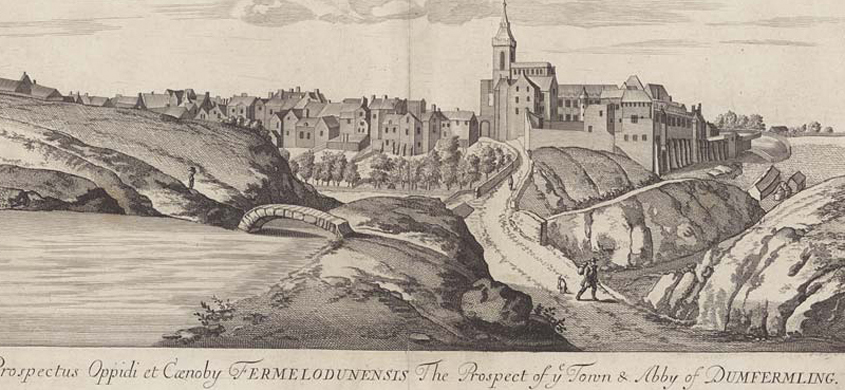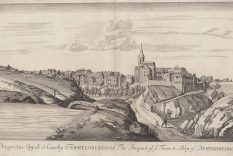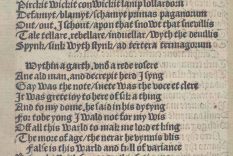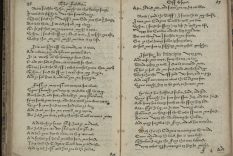
Robert Henryson (Henrisoun or Henrisoune bein ither spellins o his nemm) wis a makkar wirkin in the saicont hauf o the fifteent yearhunner c. 1460–1500. There but a pickle ken o his life, we ken fir siccar he wis associatit wi Dunfermline Abbey an maist like the split new foondit University in Glesga.
The Naitonal Leebrar o Scotland haes a wheen o his scrievins in Middle Scots, three muckle lang poems an a gowpenfu o wee’r warks, reengin ower a wheen o genres. Thae three muckle warks is Esop’s fabils, ‘In hamelie langage and in termis rude’, Orpheous an Euridices, an ‘The Testament o Cresseid’.
‘The Testament O Cresseid’ is a wark, in Middle Scots, takin efter Geoffrey Chaucer’s Middle English classic ‘Troilus and Criseyde’ scrievit mibbie juist shy o a hunner year aforehaun. Whaurin the wird o Chaucer’s Criseyde isnae telt, Henryson’s poem tells us whit happened tae Cresseid efter thon story ends. Some o the earliest editions o Chaucer, sic as 1532’s ‘The Workes of Geffray Chaucer’ haed the ‘Testament of Cresseid’ prentit as a epilogue tae Chaucer’s wark.
Lear mair aboot The Testament of Cresseid
Robert Henryson wis a makar thit floorishit in the saicont hauf o the fowerteen hunners. He bade in Dunfermline whaur evidens suggests he wis a scule-maister trainit in law an humanities. Ayont this maist ither thochts is suppositioun. We ken thir fae William Dunbar’s poyum ‘I that in Heill Wes and Gladness’ (The Lament for the Makars) uisually datit tae 1505. This poem gings throu a wheen o makkars thit is kent tae Dunbar an thit hae dee’d awa. In this wyse Henryson is mindit (‘he’ bein deith, mortis):
In Dunfermelyne he has done roune
With maister Robert Henrisoune.
Frae the title ‘maister’ hit is taen thit Henryson is a body wi a university degree. There nae record o his bein at St Andras university which wis foondit in 1413. Houaniver there a record o a Robert Henryson in 1462 wi a license fir tae lairn fowk takkin a post at Glesga University no lang foondit syne 1451. The fak he’s no doon as a student maks it likely he wis at a university ayont Scotland.
There anither record o a witness kent as Robert Henryson in the chairters o Dunfermline Abbey. Gien thit Dunbar pits him in thon toon, a Royal Broch wi a Gremmar scule, hit seems like it thit he’d hae been a notary there an aa.
Prentit Editions
‘The Testament o Cresseid’ is fir tae be fun in prent an manuscripts throu the saxteent yearhunner. Ae notable appearance is a stanza in ‘The Book o the Dean o Lismore’, a soorce fir Gaelic poetry scrievit in Scots orthography an haunwritin athin whilk there Scots, English an Latin warks fir tae be foond.
The auldest edition tae bide on tae this day is in ‘The Workes of Geffray Chaucer’ imprentit in Lunnon in 1532. This haes ‘The Testament’ prentit as a ‘saxt buik’ o Chaucer’s ‘Troilus and Criseyde’ an wi this tradition led tae the wark bein attributit tae Chaucer hissel fir ower a hunner year. Athin the text, wis the language no eneuch tae coonter thon claim, the narratour references Chaucer. Sae fowk kent hit clearly as Henryson’s wark efter tim.
In Scotland, hit’s taen thit Chepman & Myllar, wir first prenters an prenters o Henryson’s ither warks, haed pitten oot a edition in 1508. Nae copies survive, but fae ither soorces hit’s kent thit the wark wis in prent afore the prentin o ‘The Testament of Cresseid’ in Embra bi Henrie Charteris, in 1593 – the maist reliable text fowk wirk fae.
The Text
‘The Testament o Cresseid’ is sometimes presentit as a sequel tae Chaucer, houaniver gien thit there different treatment o the text hit’s noo taen as a independent wark.
Henryson haes a lang prologue introducin a Scots authour discrievin affie dreich an doolie weather, an giein his doots on luv. He gies note o Chaucer’s wark an then presents the forcomin story as comin fae a buke thit’s mibbie Chaucer, or coonterfeit, tellin Cresseid’s story, an dootin whither hit’s suithfae or an invention.
The narratour then gies a precis o Chaucer’s story, o hou Cresseid wis Troylus’ luv, syne swappit in a prisoner exchange an then ner cam back tae him, insteid fawin fir her captor, thit syne rejects her.
In the main story Cresseid is then telt fir tae hae gane tae the hoose o her faither whaur she offends the gods Venus an Cupido fir causin her wae in luv. Syne she faws doon in a reverie whaur the gods appear an gaither in coort tae try her fir her sins. Their judgement is haurd an hit’s dempt thit she is transformit intae a leper.
Upon awakenin an seein hersel, she noo repents. Fawin fae grace she bides amang the beggairs tae ae day her former luv, Troylus, cams by. Naen recognises the tither, but efter Troylus haes gien ower generous alms, fir mindin on Cresseid but athoot recognition o her afore him, Cresseid is telt wha gied the alms an is birlt intae a state o heich emotion. She then gies her Testament an dees.
Tae cap aff the story the narratoun syne presents the story as a warnin tae weemin. There muckle debate tae this day amang readers anent his, an Heryson’s, sympathy taewart the weird o Cresseid.
Robert Henryson (Henrisoun or Henrisoune are other spellings of his name) was a poet working in the second half of the 15th century. There is very little known of his life apart from his association with Dunfermline Abbey and most likely, the University of Glasgow.
The National Library of Scotland holds a number of his manuscripts written in Middle Scots – three large pieces and a large handful of other works covering a wide number of genres. The three large works are Aesop’s Fables, a marvellous story of Orpheus and Euridice, and the ‘Testament of Cresseid’.
The ‘Testament of Cresseid’ is a work, in Middle Scots, inspired by Geoffrey Chaucer’s Middle English classic ‘Troilus and Criseyde’, written less than 100 years before. Whereas the fate of Criseyde is left untold in Chaucer’s earlier poem, Henryson’s work tells her story. Some of the earlier editions of Chaucer, such as 1532’s ‘The Workes of Geffray Chaucer’ had the ‘Testament of Cresseid’ presented as an epilogue to Chaucer’s work.
Learn more about The Testament of Cresseid
Robert Henryson is recognised as one of the Scots makars who flourished in the second half of the 15th century c. 1460-1500. He lived in Dunfermline where it is believed he was a schoolmaster trained in law and humanities. Beyond this, most other biographical details are guesswork. We know from William Dunbar’s poem ‘that in ‘Heill Wes and Gladness’ (The Lament for the Makars), usually dated to 1505 that it is a pageant of poets known to Dunbar who are all long, or recently, deceased. Thus Henryson is remembered (‘he’, here, being death):
In Dunfermelyne he has done roune
With maister Robert Henrisoune.
From this title ‘maister’ it is accepted that Henryson had a university degree. There is no record of him at the University of St Andrews which had been founded in 1413. However, there is a record of a Robert Henryson in 1462 with a licence to teach taking up a post at the University of Glasgow, founded a few years earlier in 1451. The fact there is no record of him as a student makes it likely he was at a university outside Scotland.
There is another record of a witness to the charters of Dunfermline Abbey known as Robert Henryson. Given Dunbar places Henryson there, and it being a royal Burgh with a grammar school, it seems likely that he would have been a notary there too.
Printed editions
‘The Testament of Creseid’ is found in print and in manuscripts throughout the 16th century. One notable apperance is a stanza in The Book of the Dean of Lismore, a source for Gaelic poetry written in Scots orthography and handwriting which also contains Scots, English and Latin works.
The oldest surviving edition is in ‘The Workes of Geffray Chaucer’ printed in by Thomas Godfray in 1532. This has the ‘Testament’ printed as a ‘sixth book’ of Chaucer’s ‘Troilus and Chrieyde’, and this led to the work being attributed to Chaucer himself for over 100 years. Within the text, if the Scots language were not enough to counter that claim, the narrator refers to Chaucer. Consequently, after time, people came to recognise it as Henryson’s work.
In Scotland it’s assumed that Chepman & Myllar, Scotland’s first printers and printers of Henryson’s other works, had published an edition in 1508. No copies of this survive however but from other sources it is known that there were printed editions before the printing of ‘The Testament of Cresseid’ in Edinburgh by Henrie Charteris in 1593, the most reliable text which is widely drawn from.
The Text
‘The Testament of Cresseid’ is sometimes presented as a sequel to Chaucer’s Troilus and Criseyde, however, given that there is different treatment of the story it’s now considered an independent work.
Henryson has a long prologue introducing a Scots author describing dark and troublesome weather and providing us with his thoughts on love. He refers to Chaucer’s work and then presents the forthcoming story as coming from a book that, perhaps written by Chaucer or counterfeit, that tells the story of Cresseid. He also questions the truth of the account.
The narrator then gives a recap of Chaucer’s story, how Cresseid was Troylus’ love, swapped in a prisoner transfer who never returned to him, instead falling in love with her captor, who ultimately rejects her.
In the main narrative Cresseid then leaves for her father’s house where she offends the gods Venus and Cupid for their causing her woe in love. Then she falls into a reverie where the gods appear to judge her for her transgressions. They deem that she be transformed into a leper.
Upon her awakening, and seeing her disfigurement, she repents. Fallen from grace she goes to live among the beggers until one day her former love, Troylus happens by. Neither recognise one another, but Troylus feels compelled to give generously to her. Afterwards Cresseid is told that it had been Troylus who gave so generously. This compels her to give her testament and she immediately dies.
To finish the work the narrator then presents the story as a moral warning to women. There is much debate to this day as to whether the narrator and Henryson has sympathy towards the fate of Cresseid.
- Author:
- Robert Henryson
- Publication Date:
- 1508
- Imprentit:
Edinburgh




